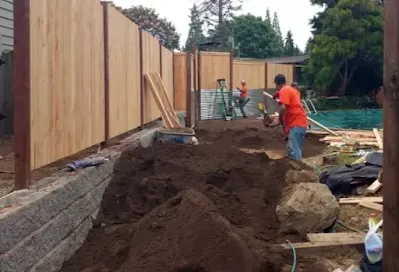How To Level A Yard With Fill Dirt
Every project in your backyard requires a level yard. For most individuals, a level backyard will require some hard labor and fill dirt. Land grading is used to level your backyard.
What Is Land Grading?
Land grading is the process of leveling or sloping land to make a foundation for a building. Land grading can also be used to fix drainage issues, avoid flooding, level a backyard for better use, or terrace a hillside yard.
The most popular forms of dirt for projects are Virginia fill dirt and topsoil. Both have distinct chemical compositions and thus distinct purposes. Topsoil is crucial for gardening and farming since it is nutrient-rich. Plants would struggle to grow in fill dirt because it lacks the necessary nutrients.
Why Use Fill Dirt For Grading?
Construction uses fill dirt, such as laying foundations or grading land. Because topsoil contains organic stuff that breaks down over time, it cannot be used for foundations or land grading.
The topsoil volume will change, potentially shifting any foundations on top. This is a difficulty in land grading because if you fill a low place, it will eventually return due to the changing volume of the topsoil.
Why Can't Topsoil Be Used For Grading?
You can't utilize dirt from another part of your yard because it has organic matter in it. You have no way of knowing if that dirt contains organic matter, so you can't ensure that it will keep your yard level.
Buying fill dirt from a contractor ensures that it is free of organic matter, pollutants, and big debris.
How To Level A Backyard With Fill Dirt
To begin leveling your yard, you must first define the exact area to be leveled. This could be a little plot of land or your entire backyard. To begin, remove all grass, trees, and vegetation from the area. Then, using stakes, mark the grading area's parameters. Once the stakes are in place, decide what height is "level".
It's usually easier to build up the ground than to excavate and remove dirt, especially because you'll need to add dirt anyway. Find a point inside your bounds and stake it.
Once you've settled on a height, utilize your fill dirt to build that all places within the restrictions reach that height. Placing the fill dirt is easy, but you must pack it down afterwards to prevent it from moving. After compacting the dirt, you will find that the region is just a bit too low to reach your level point.
The Importance of Fill Dirt in Backyard Leveling
A level backyard is beneficial for many purposes. A level backyard can truly solve many issues. For example, if you have drainage issues and rainwater floods, land grading is the solution. Find the high and low points of your drainage issue to fix it. The high point is where the water flows backwards.
Suppose the terrain slopes down towards your house, and the high point is at the very top of the slope. The low point is where the water pools, therefore it's at the slope's base. Fill the low spot with enough dirt to level it with the high point. The fill dirt will level the slope and prevent water from accumulating where you don't want it.
A level backyard is also required for any building project. A level yard is the first step to a solid foundation for a shed, basketball court, or above-ground pool.
If you start any of those projects on a slope in your backyard, you will struggle to finish them because you will have to make substantial adjustments to compensate for the slope. This is true even for a minor slope that is barely noticeable when passing by. Before starting any job, be sure the land is level. If not, be sure to appropriately alter the slope and start your project on the right foot.
In conclusion
Having trouble grading or leveling your backyard? It is advisable to choose a competent fill dirt contractor with experience leveling front, side, and backyards and assisting homeowners with construction projects. Incorrectly done and without a contractor, your yard may wind up uneven or damaged.
Read also How Much Does Leveling a Yard Cost?


